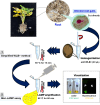Development of colorimetric and fluorescent closed tube LAMP assay using simplified extraction for diagnosis of Meloidogyne enterolobii in root tissues
- PMID: 39747178
- PMCID: PMC11696552
- DOI: 10.1038/s41598-024-83214-9
Development of colorimetric and fluorescent closed tube LAMP assay using simplified extraction for diagnosis of Meloidogyne enterolobii in root tissues
Abstract
Meloidogyne enterolobii, a guava root-knot nematode, is a highly virulent pest in tropical and subtropical regions causing galls or knots in roots of diverse plant species posing a serious threat to agriculture. Managing this nematode is challenging due to limitations in conventional identification based on isolation and microscopic classification requiring expertise and time. A colorimetric and fluorescent LAMP assay using simplified extraction method targeting rDNA-ITS region was developed to detect M. enterolobii DNA. The Men-LAMP assay exhibits simple procedure and achievable outcomes directly from root gall samples within 75 to 80 min, using a simplified Worm Lysis Buffer Plus (WLB +) extraction and the LAMP assay. The results could be interpreted using color and fluorescence without requiring post-amplification to minimize any possibility of contamination. The specificity showed no cross amplification with other plant-parasitic nematodes, a sensitivity was limited to 2.89 ng/μL. Our study proposes a sensitive, specific and time-efficient diagnostic tool for M. enterolobii infection as an alternative promising method for rapid and effective diagnosis at point-of-service to manage and control of M. enterolobii in export plants that can contribute to the degradation of trade restrictions and streamline of the international quarantine inspection process.
Keywords: Meloidogyne enterolobii; Extraction; LAMP; Parasite; Root; SYBR.
© 2024. The Author(s).
Conflict of interest statement
Declarations. Competing interests: The authors declare they have no competing interests.
Figures





Similar articles
-
First Report of Meloidogyne enterolobii Infecting Tomato (Solanum lycopersicum) in Texas, United States.Plant Dis. 2025 Jun 26. doi: 10.1094/PDIS-04-25-0740-PDN. Online ahead of print. Plant Dis. 2025. PMID: 40570356
-
Development of Enzyme-Mediated Duplex Exponential Amplification Assay for Detection and Identification of Meloidogyne enterolobii in Field.Microorganisms. 2025 Jun 11;13(6):1353. doi: 10.3390/microorganisms13061353. Microorganisms. 2025. PMID: 40572240 Free PMC article.
-
Psidium Defenses Against Meloidogyne enterolobii: Proteomic and Microscopic Analysis of this Plant-Predator Association.Proteomics. 2025 Aug;25(16):17-27. doi: 10.1002/pmic.70015. Epub 2025 Jul 26. Proteomics. 2025. PMID: 40714756 Free PMC article.
-
Signs and symptoms to determine if a patient presenting in primary care or hospital outpatient settings has COVID-19.Cochrane Database Syst Rev. 2022 May 20;5(5):CD013665. doi: 10.1002/14651858.CD013665.pub3. Cochrane Database Syst Rev. 2022. PMID: 35593186 Free PMC article.
-
Meloidogyne enterolobii risk to agriculture, its present status and future prospective for management.Front Plant Sci. 2023 Jan 24;13:1093657. doi: 10.3389/fpls.2022.1093657. eCollection 2022. Front Plant Sci. 2023. PMID: 36762171 Free PMC article. Review.
References
-
- Salazar-Mesta, R. J. et al. Characterization, pathogenicity, and reproduction of Meloidogyne enterolobii populations parasitizing vegetables in Sinaloa, Mexico. Trop. plant pathol.48, 394–407. 10.1007/s40858-023-00576-7 (2023).
-
- Bui, H., Gu, M., Riva, G. & Desaeger, J. Meloidogyne spp. infecting asian vegetables in central florida, USA. Nematropica52, 56–63 (2022).
-
- Jindapunnapat, K., Chinnasri, B. & Kwankuae, S. Biological control of root-knot nematodes (Meloidogyne enterolobii) in guava by the fungus Trichoderma harzianum. J. Dev. Sus. Agr.8, 110–118. 10.11178/jdsa.8.110 (2013).
-
- Wu, C. et al. First report of the guava root-knot nematode (Meloidogyne enterolobii) on Selenicereus costaricensis in Guangxi, China. Plant Dis.17, 4034. 10.1094/pdis-04-23-0736-pdn (2023).
Publication types
MeSH terms
Supplementary concepts
LinkOut - more resources
Full Text Sources

